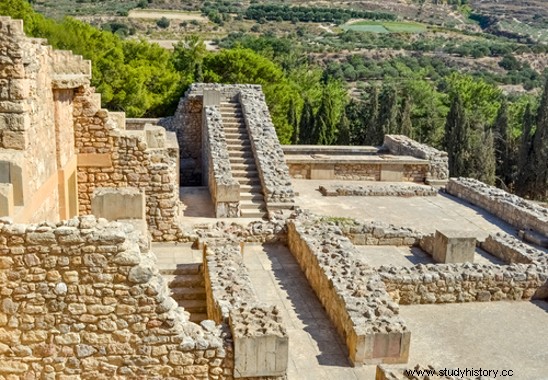
By Me. Cláudio Fernandes
The Cretan and Mycenaean civilizations , or Minoan and Mycenaean, developed around 2000 BC. C., in the region that comprises the extreme south of Greece, having thus preceded the city-states of the Greek civilization , such as Thebes, Athens and Sparta. The Cretan civilization flourished on the island of Crete, which is in the Aegean Sea. It is also called Minoan after the legendary King Minos, who would have founded such a civilization. The Mycenaean civilization was structured on the mainland, around the city of Mycenae , located near Athens.
The city-state that held the center of Cretan civilization was Knossos . In this city, the king's palace constituted the central point from which all the organization of the city started. In addition to being a monumental construction, the Cretan palace was a complex engineering work. Its structure had aqueducts built with terracotta that irrigated water from miles away. Its interior was specially designed to accommodate the entire royal family and all the subordinates who managed the administration of the city. In addition, the walls of the palace's interior precincts were carefully ornamented and painted using the fresco technique.
Archaeologists and historians speculate that the end of Cretan civilization dates back to 1450 BC. C. Around that year, the city of Knossos would have been destroyed either by a volcano or by the looting of the Mycenaean civilization. The latter, the Mycenaean civilization, began to form around 1600 BC, reaching its apogee between 1400 and 1230 BC. The Mycenaeans descended from the invading Indo-European tribes that fed migratory waves to southern Europe from the year 2000 BC, as did the Dorians, Ionians, Aeolians and Achaeans, who would go on to build the other civilizations of ancient Greece.
The entire administrative, economic and cultural structure of the Mycenaeans, who were eventually conquered by the Dorian tribes, was inherited from the Cretans — civilization to which they submitted their yoke. The characteristic of the centrality of the king's palace was also present among the Mycenaeans, whose importance was recorded by the scholar of Greek thought, Jean-Pierre Vernant, as can be seen in the following excerpt:
“When in the twelfth century, before our era, the Mycenaean power collapsed under the impetus of the Doric tribes that erupted in mainland Greece, it was not a simple dynasty that succumbed in the fire that raged alternately Pylos and Mycenae, is a type of royalty that is forever destroyed, a whole form of social life, centered around the palace, which is definitively abolished, a character, the divine King, who disappears from the Greek horizon. The collapse of the Mycenaean system far exceeds, in its consequences, the domain of political and social history. (VERNANT, J.-P. As origins of thought Greek . São Paulo:Difel, 1984, p.6).
Take the opportunity to check out our video lesson on the subject:
